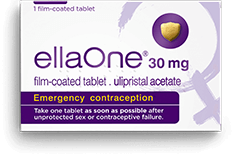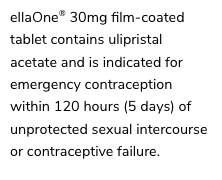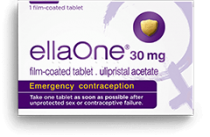What are the different types of emergency contraception?
Did you know that there is more than one type of emergency contraception?
Whether you’ve missed your pill, the condom has split or you forgot to use contraception altogether, you might be considering using emergency contraception. It can feel a little overwhelming, so we’ve created this guide to introduce you to your emergency contraceptive options.
There are two methods: oral emergency contraception (known as the morning after pill) and the copper intrauterine device (sometimes called the copper coil).
Whichever method you choose, it’s important to remember that any emergency contraceptive will be most effective the sooner you use it.
The emergency contraceptive pill
The morning after pill can help prevent pregnancy by delaying ovulation. This means that after unprotected sex, no egg is released and sperm can’t fertilise anything.
Lots of people don’t know that there are two different types of morning after pill: one containing ulipristal acetate (contained in ellaOne) and another containing levonorgestrel.
Levonorgestrel can be effective when taken up to 72 hours after unprotected sex, whereas ellaOne can be effective for up to 120 hours afterwards.
You do not need a prescription to get the emergency contraceptive pill. It can be given to you by a pharmacist, doctor, sexual health clinic or it can be ordered online pick up in store. It can also be obtained free of charge to medical card holders.
You will be asked some questions before being given the morning after pill, to make sure that the medicine is suitable for you. For more information about that, see here.
Some people experience side effects after taking the morning after pill, but these are normally mild, and not everyone experiences them. If you vomit within 3 hours of taking the morning after pill you will need to take another dose, as it will not be effective.
The copper intrauterine device
The copper IUD can be used as emergency contraception when inserted up to 5 days after unprotected sex.
To get an IUD fitted, you will need to make an appointment with a doctor or nurse. The IUD is non-hormonal, it works by releasing copper into the womb, which alters the cervical mucus to make it difficult for sperm to survive and for a fertilised egg to implant.
The copper coil isn’t just used for emergency contraception: it’s what’s known as a long-acting reversible contraceptive (LARC). This means that once it is implanted, it can be effective contraception for 5-10 years.
As you will have to wait for an appointment to get the IUD inserted by a doctor or nurse, you might consider using oral emergency contraception in the meantime. This means that if anything changes with your IUD appointment, or you aren’t able to get one fitted in the time it will be effective, that you have already taken a precaution against unplanned pregnancy.
How do I know which emergency contraceptive is right for me?
If you’re reading this, then you’re already doing the right thing by doing your research.
If you have more specific questions, or an underlying medical condition, the best thing to do is to talk to a healthcare professional about your options. They are there to help you, not to judge, and they are best placed to understand your individual circumstances.
To understand more about the key differences between different types of emergency contraception, we’ve laid out some basic information:
| |
Ulipristal Acetate (contained in ellaOne) |
Levonorgestrel |
Copper Coil |
|---|---|---|---|
|
How do I take it? |
One tablet, it can be swallowed with water at any time in the menstrual cycle. | One tablet, it can be swallowed with water at any time in the menstrual cycle. | A small T-shaped device that is inserted into the womb by a doctor or nurse |
When can it be effective? |
Up to 5 days after unprotected sex | Up to 3 days after unprotected sex | Up to 5 days after unprotected sex |
When is it most effective? |
As soon as possible after unprotected sex. | As soon as possible after unprotected sex. | As soon as possible after unprotected sex. |
How does it work? |
Delays ovulation so sperm have no egg to fertilise. | Delays ovulation so sperm have no egg to fertilise. | Alters cervical mucus to prevent implantation. |
Where can I get it? |
You can get the morning after pill from a pharmacy without a prescription, from a doctor, sexual health clinic, or by ordering online. | You can get the morning after pill from a pharmacy without a prescription, from a doctor, sexual health clinic, or by ordering online. | You will need to make an appointment with a doctor or sexual health clinic to get the copper coil inserted. |
How much does it cost? |
Around 35 € | Between 15 € to 27 €, depending on the brand. | Free. |
When is it NOT suitable? |
It is suitable for most people, but some medicines can interact with ellaOne. It will have no effect if you are already pregnant. You can check whether ellaOne is suitable for you here. | It is suitable for most people, but some medicines can interact with levonorgestrel. It will have no effect if you are already pregnant. | It is not suitable if you are already pregnant or if you have other problems with your womb or your cervix |
Can I use it if I am breastfeeding? |
Yes, but you should express and discard your milk for one week after using ellaOne. | Yes, but you should avoid breastfeeding for at least 8 hours after using it. | Yes. |
Does it protect against STIs? |
No | No | No |
Will it protect me against future instances of unprotected sex? |
No | No | Yes - it can be effective for 5-10 years, depending on the type. |
It’s important to know that if you’ve had unprotected sex, there are still options available to help prevent an unplanned pregnancy. We know it can feel scary, but you can still take control of the situation.
For more information about ellaOne, check out this article.
***
ellaOne® 30mg film-coated tablet contains ulipristal acetate and is indicated for emergency contraception within 120 hours (5 days) of unprotected sex or contraceptive failure. Always read the label.



